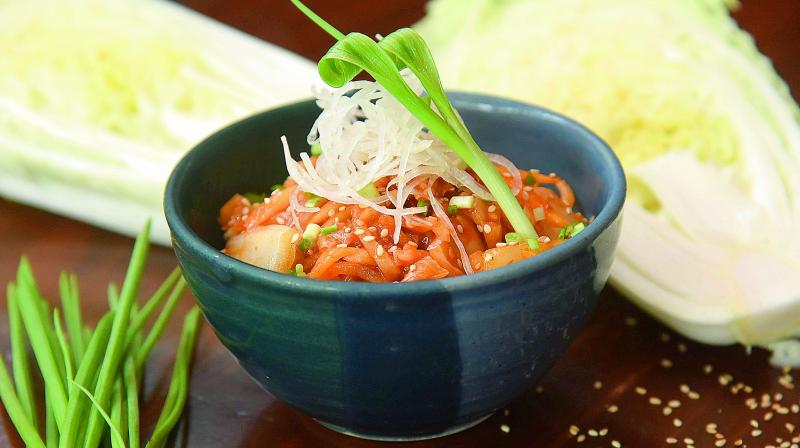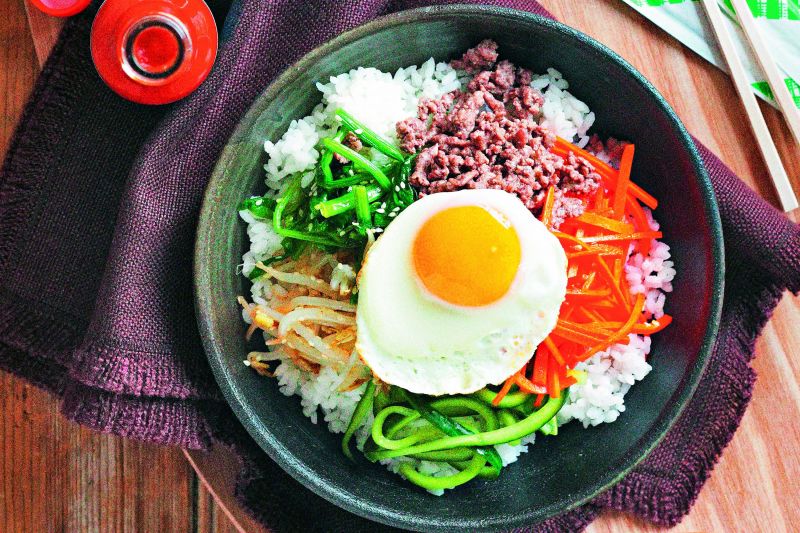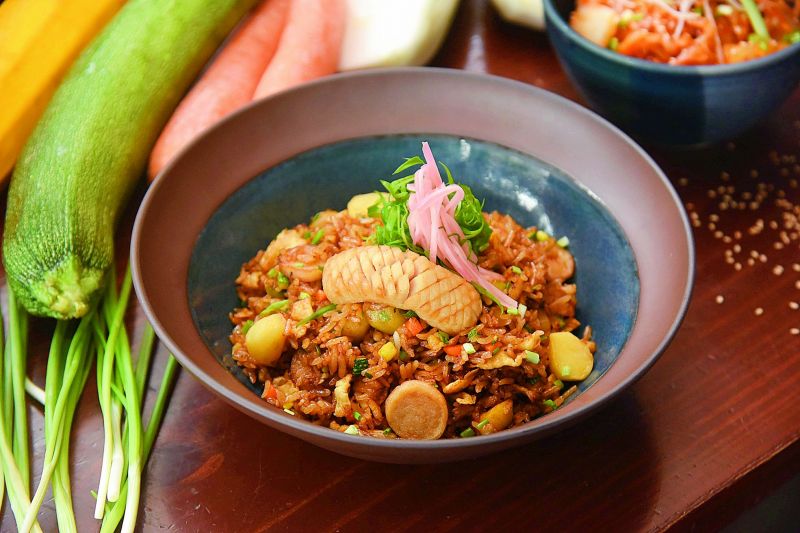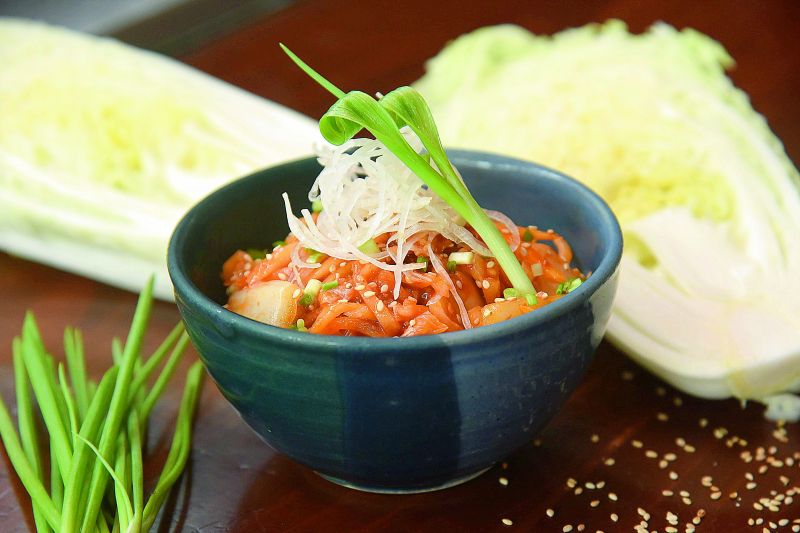More than just Kimchi

With the growing hype around Korean dramas and K-Pop bands, India is slowly opening its doors to Korean cuisine as well. It may sound exotic and far-reaching to begin with, but a closer look reveals that Korean food is not all that different from its Indian counterpart.
In fact, Korean food is known to be hearty in its portions with rice being the core ingredient for most of its dishes. Even the popular spices used in Korean cooking — primarily cinnamon — feature in most of our own Indian dishes.
The classic Bibimbap is one of the most talked about Korean dishes and a visual treat. The literal translation of the name suggests that it is an all-encompassing bowl of rice with minced meat and vegetables as accompaniments. The best part of this Korean dish is its versatility. You can easily alter it to your taste and dietary preferences.
While most of us feel hesitant in incorporating an alien cuisine in our lives over the fear of exotic ingredients priced exorbitantly, this is not the case with Korean cuisine. Most of the ingredients used can be easily found in our own local markets and kitchens.
A popular Korean dipping sauce and sometimes the core ingredient for its dishes is sesame oil. In fact, Korean food is incomplete without this nutty aromatic addition to its dishes. Widely used in our own cooking, sesame oil is known to have some great health benefits too.
Another Korean essential is coconut milk, largely used in the southern parts of India; coconut milk gives a sweet and smooth flavour to the dishes.
Like Indian food, Korean food can sometimes be extremely rich in spices, so the addition of coconut milk not only adds a layer of flavour but also ties the whole dish together. Try your hand at these exotic but easy to make Korean dishes.
Korean Bibimbap (serves 4)
Ingredients:
- 500gms cooked short-grain rice
- 250gms bean sprouts, washed and drained (any lentil )
- 400gms of spinach blanched and washed with the excess water squeezed out by hand
- 250gms carrot
- 1 zucchini
- 1 cucumber
- 4 green onions, chopped
- 20gms garlic caramelized
- 100gms sliced caramelized onion
- 300gms fresh lean cut of beef (fillet) and/or chicken breast
- 4 eggs
- 50ml vegetable oil
- 100ml sesame oil
- 20gms sesame seeds
- 50ml light soy sauce
- 10gms Honey (or sugar)
- Korean hot pepper paste (gochujang)
- Salt to taste
 Korean Bibimbap
Korean Bibimbap
Preparation:
- Let the cooked rice stand, covered, at room temperature to keep it warm.
- Blanch Spinach leaves and drain out the water.
- Boil sprouts in salt water and keep aside.
- Finely slice the carrot.
- Slice the zucchini length-wise.
- Cut the cucumber in halves, length-wise.
- Cut the beef/chicken length-wise.
Accompaniments for the Bibimbap:
- In a bowl, mix the boiled sprouts by hand with ½ tsp salt, 1 tap minced garlic, and 2tsp sesame oil. Place this on a large platter.
- Cut up the blanched spinach a few times and put it in a bowl. Mix by hand with 1 tsp garlic, 1 tsp sesame oil, ½ tsp salt, and 1 tsp sesame seeds.
- Mix the sliced carrots with a pinch of salt. Let it stand for 5 to 10 minutes until sweating.
- Mix the zucchini with ½ teaspoon salt.
- Mix the cucumber with ¼ teaspoon salt.
- Mix the beef/chicken slices with 1tbsp tablespoon minced garlic, 1 tbsp soy sauce, 1 tbsp honey, 2 tsp sesame oil, and 1tsp sesame seeds with a spoon.
Cooking:
- Heat up a pan over a medium flame. Add a few drops of cooking oil to the pan. Squeeze out excess water from the carrot and sauté it for 1 minute. Once cooked, place it on the platter next to the soy bean sprouts and spinach.
- Wipe the pan clean with a wet paper towel.
- Heat a few drops of cooking oil in the pan and squeeze out the excess water from the cucumber. Sauté with ½ tsp minced garlic and a few drops of sesame oil for 30 seconds. Put it on the platter. Clean the pan.
- Heat up the pan and squeeze out excess water from the zucchini. Add a few drops of cooking oil and sauté with 1tsp minced garlic, 1tbsp chopped green onion and a drop of sesame oil for 1 minute until slightly softened. Put it on the platter. Clean the pan.
- Heat oil in a pan over medium heat, toss the Beef/chicken at medium high heat until cooked.
Serve:
- Re-heat the soybean sprout soup. Season and garnish with chopped spring onion and serve it as a side.
- Divide the cooked rice into 4 portions. Each portion will be a little more than 1 cup of rice.
- Put the rice in separate bowls and arrange the vegetables and beef on and around the rice.
- Prepare a sunny side up/fried egg and place it over the rice.
- Slightly pan-fry the beef/chicken before putting them on the top of rice.
- Sprinkle the Bibimbap with the sesame seeds and drizzle some sesame oil for added flavour.
- Serve right away with some hot pepper paste (gochujang) on the side.
— Chef Sanjay Kak (Culinary Director IIHM)
Bokkeumbap
Ingredients:
- 1 bowl cooked rice
- 5-6 chicken sausages.
- 1 medium carrot
- 1 potato
- 1 zucchini
- 1 onion
- 8-10 cloves of garlic
- One bunch of spring onions
- 2 eggs
- 2tsp soy sauce
- 2tbsp sesame oil
- 50gms sesame seeds
Preparation:
- Cut sausage into rough one inch cubes
- Finely chop all vegetables, length-wise.
 Bokkeumbap
Bokkeumbap
Process
- Preheat wok and add 2tbsp of sesame oil.
- Once the oil is hot, add the sausages and garlic first.
- When the garlic is slightly brown add potatoes, carrots, zucchini and onions.
- Keep stirring in order to avoid the vegetables from burning.
- Once the vegetables are cooked add the cooked rice to the wok.
- Whisk one egg into the rice mix, stirring constantly to completely incorporate the egg.
- Once the egg is cooked add 2tsp of soya sauce and 2tsp of sesame oil.
- Garnish the dish with spring onions and roasted sesame seeds for that added crunch.
Kimchi
Ingredients:
- 1 Chinese (napa) cabbage.
- Kosher salt to taste.
- 4tbsp Vinegar.
- 2tbsp Sesame oil.
- 2 tbsp Tomato ketchup.
- 2 tbsp Korean kimchi paste.
- 8-10 cloves of garlic.
- 20gms ginger.
- 50gms sesame seeds.
- Spring onions for garnish.
- 1 medium radish.
- 2tsp Sugar.
- 2tbsp fish sauce.
- 100gms rice flour
- 100ml water.
Method:
- Slice the cabbage in half, without shredding the densely packed leaves inside.
- First make a small slit at the base of the cabbage. Dunk the leaves in a large bowl of water with salt and vinegar
- Let the cabbage rest in this water for two hours. Turn them over every 30 minutes, so they get marinated evenly.
- After two hours wash the cabbage under cold water thoroughly.
- Combine the remaining vinegar and salt water along with rice flour in a bowl and mix well.
- Heat this mix on a low flame for 10 minutes until it starts to bubble.
- Then add 2tsp of sugar and reheat.
- Remove it from the heat and let it the mix cool.
- To the cool mix add chopped garlic, ginger, kosher salt, radish and onion.
- Add 2tbsp of fish sauce, Korean kimchi paste and tomato ketchup to the paste and mix it well
- Spread this mix evenly on each cabbage half and wrap it.
- Store it in a dry place for a day or two at room temperature.
- When the cabbage (kimchi) is soft and ready to eat then store it in your fridge.
- Garnish it will the sesame seeds and chopped spring onion and serve it as a side with the Bokkeumbap.
 Kimchi
Kimchi
Courtesy: Haiku
Do you know
- Bibimbap literally means “mixed rice.” It contains a variety of vegetables placed on top of white rice, along with a spoonful of red pepper paste. Add an egg and some meat.
- Bokkeumbap means “fried rice.” While there are many varieties of bokkeumbap, the most famous kind is kimchi bokkeumbap.
- Korean food is known to be hearty in its portions with rice being the core ingredient for most of its dishes.
- Fermented foods are also part of the Korean meal. These fermented foods can include mung beans, pickled cabbage, and a staple food known as Kimchi. These fermented dishes are thought to have healing properties and promote healthy digestion.

